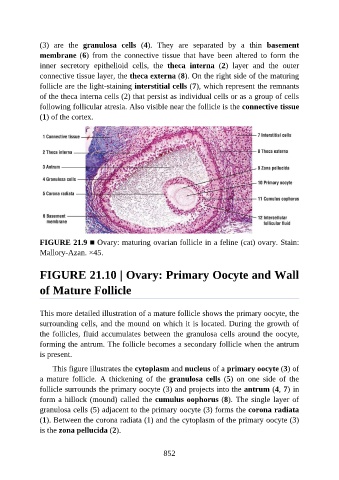Page 853 - Atlas of Histology with Functional Correlations
P. 853
(3) are the granulosa cells (4). They are separated by a thin basement
membrane (6) from the connective tissue that have been altered to form the
inner secretory epithelioid cells, the theca interna (2) layer and the outer
connective tissue layer, the theca externa (8). On the right side of the maturing
follicle are the light-staining interstitial cells (7), which represent the remnants
of the theca interna cells (2) that persist as individual cells or as a group of cells
following follicular atresia. Also visible near the follicle is the connective tissue
(1) of the cortex.
FIGURE 21.9 ■ Ovary: maturing ovarian follicle in a feline (cat) ovary. Stain:
Mallory-Azan. ×45.
FIGURE 21.10 | Ovary: Primary Oocyte and Wall
of Mature Follicle
This more detailed illustration of a mature follicle shows the primary oocyte, the
surrounding cells, and the mound on which it is located. During the growth of
the follicles, fluid accumulates between the granulosa cells around the oocyte,
forming the antrum. The follicle becomes a secondary follicle when the antrum
is present.
This figure illustrates the cytoplasm and nucleus of a primary oocyte (3) of
a mature follicle. A thickening of the granulosa cells (5) on one side of the
follicle surrounds the primary oocyte (3) and projects into the antrum (4, 7) in
form a hillock (mound) called the cumulus oophorus (8). The single layer of
granulosa cells (5) adjacent to the primary oocyte (3) forms the corona radiata
(1). Between the corona radiata (1) and the cytoplasm of the primary oocyte (3)
is the zona pellucida (2).
852

